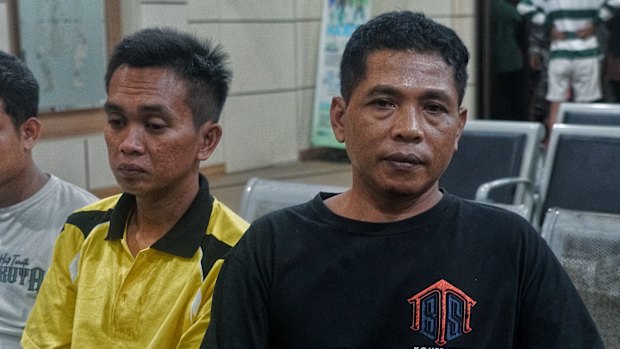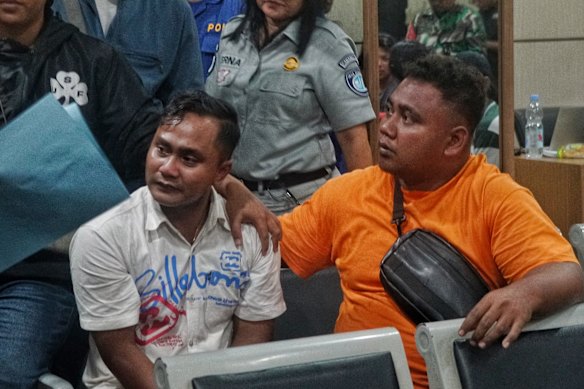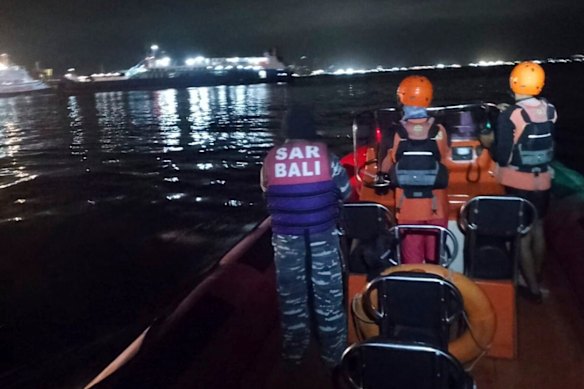By Amilia Rosa and Zach Hope
It was a pleasant coincidence for Bejo Santoso that in his maxi taxi to the ferry terminal in Indonesia’s Banyuwangi regency there were two people hailing from his village.
It was a mother and a three-year-old boy, on their way to Bali’s Gilimanuk port and continuing on in the taxi to Denpasar, where the woman’s husband was waiting for them.

Bejo Santoso (right) with Muhamad Kholil, who is waiting for news on his missing wife, Siti.Credit: Amilia Rosa
Bejo and the woman chatted. She was going home to her immediate family. He was leaving his family to go back to his Bali construction job. At the ferry, he helped the boy up the stairs, then watched as mother and child made their way to the centre of the cabin, for it was too windy on the deck.
Bejo went outside nonetheless and sat with the smokers on the side. It was about 10.50pm Bali time (12.50am AEST) on Wednesday night.
Not half an hour into the five kilometre ride, 22-year-old passenger Nanda Sinta noticed the boat was behaving peculiarly. Travelling the East Java-Bali route about 10 times a year, she knew the motions. Normally in big waves, the ferry rocks side to side. Now, it seemed stuck on a permanent lean.
“Then, people in the back started screaming because the boat was taking water,” she said. “It all happened so quickly.”

Nanda Sinta and her mother, shortly after being reunited following the Bali ferry tragedy. Credit: Amilia Rosa
On the side decks with the smokers, Bejo realised the boat was sinking. As it started to go down and he leapt with about 30 others into the sea, he caught a glimpse of the mother and boy still in the cabin.
Nanda jumped too. “I couldn’t swim, but my two friends could. When the ferry started sinking, I just followed along when they jumped,” she says. “Staying would mean risking sinking with the boat.”
Muhamad Kholil and his wife, Siti, both 26, were on the same side deck as Bejo. When something seemed wrong, Muhamad went to investigate, quickly returning to put a lifejacket on his wife and himself. “But before I could tie it, a wave hit us, and we were both thrown into the water,” he says.
Muhamad screamed for his wife in vain. But he did see several men with life jackets. As he could not swim, he moved towards them, thinking that his best chance of living was with a group.

People wait for news of their loved ones after a ferry disaster on the way to Bali.Credit: Amilia Rosa
“I continued shouting my wife’s name, she could swim, and she had her life jacket on. She must survive, she is still alive. I kept calling her for maybe over an hour, until I couldn’t any more. I was exhausted, the water was cold. We took our clothes and threw them away. They were weighing us down. I lost all hope.”
The small group of men Muhamad had paddled towards included Bejo, from the smokers’ sidedeck, and two older men. One of those older men, with breathing problems, died in the waves after about two hours of them waiting for rescue.
“Even after he died, I felt a sense of obligation to bring his body back with me,” Bejo says. “So I tied his body to my thighs and continued to float away, taken by the currents.”
Meanwhile, Nanda had managed to surface, to her own disbelief. After calling repeatedly for her friends, they somehow found her and helped her climb into a lifeboat packed with about a dozen people. Then they drifted, scooping water from the inflatable raft with their hands to stop it from sinking too.

Rescuers search for victims after a ferry sank between East Java and Bali.Credit: AP
“I heard a man trying to reach another rubber boat and he said, ‘I don’t have the power to reach it’. I think he might have died,” Nanda says.
About this time, Nanda’s mother, Huriati, began getting worried. Calls rang out. Texts went unseen. “I prayed that she was safe. I asked other people if they heard from her, but nothing,” Huriati says.
“When she called me that morning, I cried,” she says. “I couldn’t believe it was her. I kept saying, is this really you, Sinta, is this really you, my daughter? I immediately went out to pick her up. I haven’t stopped crying since.”
Bejo, dragging a dead body through the water while leading Muhamad and the surviving older man, tried to stay calm. He thinks this and adrenaline saved him.
About 5.30am, Bali time, a fisherman found them and hauled the trio to the beach. After gathering his thoughts and strength and prayers, they staggered to their feet and dryer land.
“Bejo kept me going,” Muhamad says. “He was a stranger, but that night and forever he will be more than my blood relative. We share something so strong that we are bonded for life.
“I will wait here in Gilimanuk until they find her [Siti, his wife]. I am not going anywhere. I know she is still alive, they just haven’t found her.”
By Friday night, more than 48 hours since the ferry from East Java to Bali sunk, six people were confirmed dead and 30 people on the manifest were still missing. The number of missing and dead is probably much higher, as it is an open secret that people who know the ferry workers get on without being counted or buying a ticket.
Nanda was one of these. So was Bejo.
Finally safe, Bejo walked into a wall of panicked people who were searching and waiting for loved ones. A distraught man showed him a photo of the woman and young boy he had spoken to on the transport to the ferry. It was the woman’s husband. He had come from Denpasar to Gilimanuk port to find them when he was told of a ferry disaster.
As the pair were not on the manifest, he wanted to know if they were on the sunken ferry or, by some miracle, still in East Java. Bejo confirmed they had been on the doomed ferry. Soon after, the mother and child were pulled dead from the water.
Get a note directly from our foreign correspondents on what’s making headlines around the world. Sign up for our weekly What in the World newsletter.